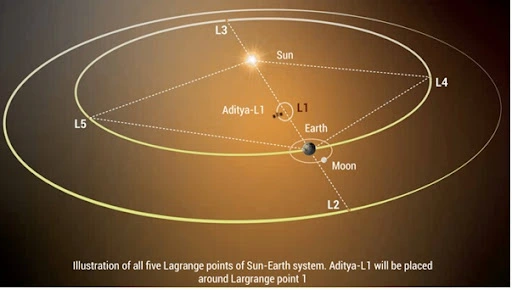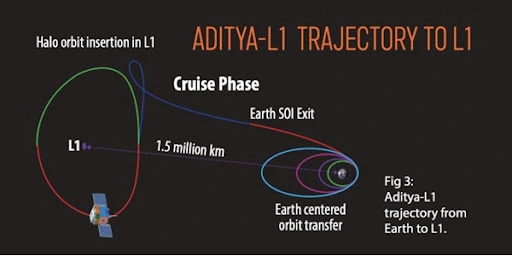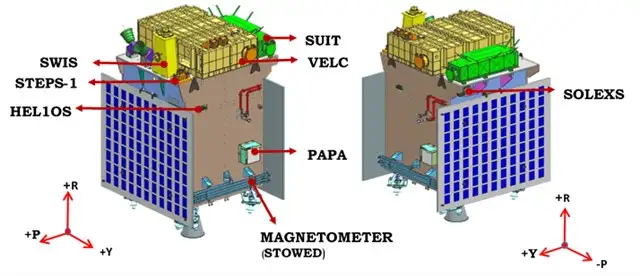What is Aditya L1?
Aditya-L1 is a satellite dedicated to the comprehensive study of the Sun. It has 7 distinct payloads developed, all developed indigenously. Five by ISRO and two by Indian academic institutes in collaboration with ISRO.
Aditya in Sanskrit means the Sun. L1 here refers to Lagrange Point 1 of the Sun-Earth system. For common understanding, L1 is a location in space where the gravitational forces of two celestial bodies, such as the Sun and Earth, are in equilibrium. This allows an object placed there to remain relatively stable with respect to both celestial bodies.
Following its scheduled launch on September 2, 2023, Aditya-L1 stays Earth-bound orbits for 16 days, during which it undergoes 5 maneuvres to gain the necessary velocity for its journey. Subsequently, Aditya-L1 undergoes a Trans-Lagrangian1 insertion maneuvre, marking the beginning of its 110-day trajectory to the destination around the L1 Lagrange point. Upon arrival at the L1 point, another maneuvre binds Aditya-L1 to an orbit around L1, a balanced gravitational location between the Earth and the Sun. The satellite spends its whole mission life orbiting around L1 in an irregularly shaped orbit in a plane roughly perpendicular to the line joining the Earth and the Sun.
LAGRANGE POINTS
For a two body gravitational system, the Lagrange Points are the positions in space where a small object tends to stay, if put there. These points in space for a two body systems such as Sun and Earth can be used by spacecraft to remain at these positions with reduced fuel consumption. Technically at Lagrange point, the gravitational pull of the two large bodies equals the necessary centripetal force required for a small object to move with them. For two body gravitational systems, there are total five Lagrange points denoted as L1, L2, L3, L4 and L5. The Lagrange points for Sun-Earth system are shown in the figure. The Lagrange point L1 lies between Sun-Earth line. The distance of L1 from Earth is approximately 1% of the Earth-Sun distance.

The strategic placement at the L1 Lagrange point ensures that Aditya-L1 can maintain a constant, uninterrupted view of the Sun. This location also allows the satellite to access solar radiation and magnetic storms before they are influenced by Earth’s magnetic field and atmosphere. Additionally, the L1 point’s gravitational stability minimizes the need for frequent orbital maintenance efforts, optimizing the satellite’s operational efficiency.
Quick Facts: Aditya-L1 will stay approximately 1.5 million km away from Earth, directed towards the Sun, which is about 1% of the Earth-Sun distance. The Sun is a giant sphere of gas and Aditya-L1 would study the outer atmosphere of the Sun. Aditya-L1 will neither land on the Sun nor approach the Sun any closer.

Science Objectives:
The major science objectives of Aditya-L1 mission are:
- Study of Solar upper atmospheric (chromosphere and corona) dynamics.
- Study of chromospheric and coronal heating, physics of the partially ionized plasma, initiation of the coronal mass ejections, and flares
- Observe the in-situ particle and plasma environment providing data for the study of particle dynamics from the Sun.
- Physics of solar corona and its heating mechanism.
- Diagnostics of the coronal and coronal loops plasma: Temperature, velocity and density.
- Development, dynamics and origin of CMEs.
- Identify the sequence of processes that occur at multiple layers (chromosphere, base and extended corona) which eventually leads to solar eruptive events.
- Magnetic field topology and magnetic field measurements in the solar corona .
- Drivers for space weather (origin, composition and dynamics of solar wind .
Aditya-L1 Payloads:

The instruments of Aditya-L1 are tuned to observe the solar atmosphere mainly the chromosphere and corona. In-situ instruments will observe the local environment at L1. There are total seven payloads on-board with four of them carrying out remote sensing of the Sun and three of them carrying in-situ observation.
ADITYA-L1 SCIENCE PAYLOADS: The Aditya-L1 mission carries a suit of seven scientific payloads to carry out systematic study of the Sun. The Visible Emission Line Coronagraph (VELC) studies the solar corona and dynamics of Coronal Mass Ejections. The Solar Ultra-violet Imaging Telescope (SUIT) payload images the Solar Photosphere and Chromosphere in near Ultra-violet (UV) and also measures the solar irradiance variations in near UV. The Aditya Solar wind Particle EXperiment (ASPEX) and Plasma Analyser Package for Aditya (PAPA) payloads study the solar wind and energetic ions, as well as their energy distribution. The Solar Low Energy X-ray Spectrometer (SoLEXS) and The High Energy L1 Orbiting X-ray Spectrometer (HEL1OS) studies the X-ray flares from the Sun over a wide X-ray energy range. The Magnetometer payload is capable of measuring interplanetary magnetic fields at the L1 point. The science payloads of Aditya-L1 are indigenously developed by different laboratories in the country. The VELC instrument is developed at the Indian Institute of Astrophysics, Bangalore; SUIT instrument at Inter University Centre for Astronomy & Astrophysics , Pune; ASPEX instrument at Physical Research Laboratory, Ahmedabad; PAPA payload at Space Physics Laboratory, Vikram Sarabhai Space Centre, Thiruvananthapuram; SoLEXS and HEL1OS payloads at U R Rao Satellite Centre, Bangalore, and the Magnetometer payload at the Laboratory for Electro Optics Systems, Bangalore. All the payloads are developed with the close collaboration of various centres of ISRO.
Other Sun & Solar Missions
Apart from the Aditya L1 Mission by ISRO which is a sun-specific mission, there are many other countries which have launched similar programs. Given below are the names of few such missions:
- NASA’s Parker Solar Probe
- NASA’s Living With a Star
- NASA’s Helios 2
Image Source: ISRO (https://www.isro.gov.in/Aditya_L1.html)